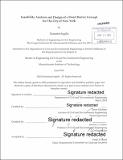Feasibility analysis and design of a flood barrier concept for the City of New York
Author(s)
Ingilis, Demetres
DownloadFull printable version (14.59Mb)
Other Contributors
Massachusetts Institute of Technology. Department of Civil and Environmental Engineering.
Advisor
Pierre Ghisbain and Jerome. J. Connor.
Terms of use
Metadata
Show full item recordAbstract
Flooding has always been a major concern for coastal communities. However, many parts of New York City never had to worry about flooding until Hurricane Sandy hit in October 2012. The hurricane brought a record level storm surge, which destroyed homes, cut power to millions of people and caused a total of $19 billion in damage. The storm surge exposed the City's critical lack of infrastructure and gave the City a major reason to address this problem. Based on projected sea level rise, floods will become more frequent and will cause regular damage to New York City. There are various ways to protect against storm surge, ranging from local barriers in each community to citywide barriers. This study addresses the feasibility and design of a two-barrier system to protect most of the City. A design is proposed where the barriers are walls with a single gate to allow ships to navigate in and out. One barrier, located under the Bronx-Whitestone Bridge, seals the City off from the Long Island Sound, which utilizes a vertical flap gate. The other barrier spans between Sandy Hook and Breezy Point utilizes a horizontally rotating arch gate. A life-cycle benefit analysis was performed to determine the time for a barrier of each height to start providing a return on investment considering upper and lower bounds on the initial construction cost. The quickest benefit occurred in just 36.66 years for a wall height of 15 feet and in just 17.32 years for a wall height of 15.5 feet for the upper and lower bounds, respectively. The chosen height for the barriers was 20 feet which required a maximum of only 1.83 additional years to provide a return on investment while protecting the City against 99.5% of all future storm surges.
Description
Thesis: M. Eng., Massachusetts Institute of Technology, Department of Civil and Environmental Engineering, 2014. Cataloged from PDF version of thesis. Includes bibliographical references (pages 65-67).
Date issued
2014Department
Massachusetts Institute of Technology. Department of Civil and Environmental EngineeringPublisher
Massachusetts Institute of Technology
Keywords
Civil and Environmental Engineering.